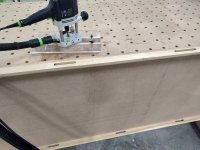The depth stop/turret on the Bosch floats on a spring too Bob so that the click positioning can work - when setting a cut depth it definitely needs to be well pushed down to bottom it out. This mind you if the sloppy posts/offset stop theory stands up may worsen any tendency for the body to tilt upon contact with it.
I'm definitely not ponying up for a 1400 without (a) confirming what is happening with the Bosch and that it's not fixable and (b) checking the a 1400 or larger Festool router very carefully.
The fine finishing cut idea and more are worth running a few more tests to try out Bill/WF.
Something is definitely happening to permit the plunge to go deeper and the cutter to tilt than the nominal depth setting when it's unlocked. I tried to remove the plunge marks by pushing down harder on the stop and taking another pass (a situation quite similar to the fine finishing cut scenario) while doing the job but no matter what I did it would not do so. It just produced more plunge marks..
In terms of minimising the problem I suspect you're right that it's probably best not to push down too hard when plunging. I'm thinking also that it might help to rework the depth stop by removing the spring/fitting a weaker one, and to partially do up the plunge lock before plunging. (the last so that it's providing some stablilisation but not producing so much friction that you can't easily overcome it)
The fit/tolerance of the guide posts in the bushings and their length of engagement must presumably be the underlying factors in this situation.
I tried to find a parts drawing for the Festool 1400 but had no luck. They talk of it locking on both posts to minimise (notably not eliminate) tilt which probably won't help much while plunging - but on the other hand they also talk of the posts being ground to tight tolerances. A bulge in the housing might or might not (?) suggest a good long guide bushes.
A PS added after posting. The parts drawing for the Bosch doesn't show the bushes separately (could it be that the posts are run directly in the aluminium plunge body?) Whatever the case the engagement is very short - more or less a necessity given that the plunge base on the GMF 1400 is removable so that it can be substituted with a fixed base.
It all seems a bit daft unless I'm missing something - why would precision plunge router need a fixed base anyway? The Festool doesn't seem to use one for example...
I'm definitely not ponying up for a 1400 without (a) confirming what is happening with the Bosch and that it's not fixable and (b) checking the a 1400 or larger Festool router very carefully.
The fine finishing cut idea and more are worth running a few more tests to try out Bill/WF.
Something is definitely happening to permit the plunge to go deeper and the cutter to tilt than the nominal depth setting when it's unlocked. I tried to remove the plunge marks by pushing down harder on the stop and taking another pass (a situation quite similar to the fine finishing cut scenario) while doing the job but no matter what I did it would not do so. It just produced more plunge marks..
In terms of minimising the problem I suspect you're right that it's probably best not to push down too hard when plunging. I'm thinking also that it might help to rework the depth stop by removing the spring/fitting a weaker one, and to partially do up the plunge lock before plunging. (the last so that it's providing some stablilisation but not producing so much friction that you can't easily overcome it)
The fit/tolerance of the guide posts in the bushings and their length of engagement must presumably be the underlying factors in this situation.
I tried to find a parts drawing for the Festool 1400 but had no luck. They talk of it locking on both posts to minimise (notably not eliminate) tilt which probably won't help much while plunging - but on the other hand they also talk of the posts being ground to tight tolerances. A bulge in the housing might or might not (?) suggest a good long guide bushes.
A PS added after posting. The parts drawing for the Bosch doesn't show the bushes separately (could it be that the posts are run directly in the aluminium plunge body?) Whatever the case the engagement is very short - more or less a necessity given that the plunge base on the GMF 1400 is removable so that it can be substituted with a fixed base.
It all seems a bit daft unless I'm missing something - why would precision plunge router need a fixed base anyway? The Festool doesn't seem to use one for example...

